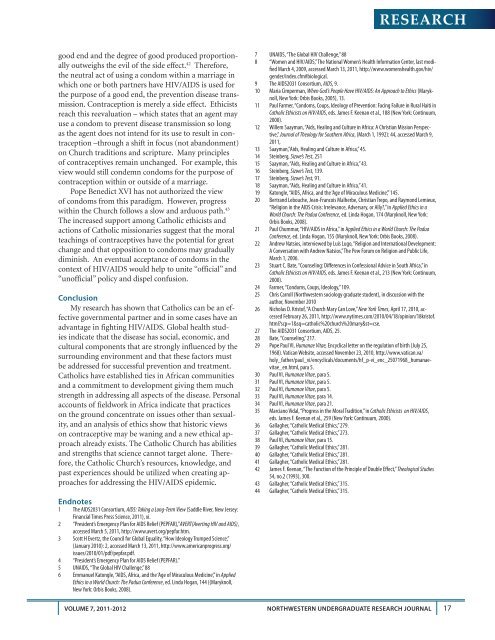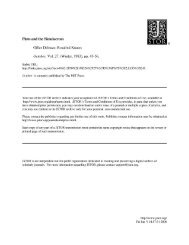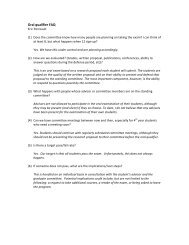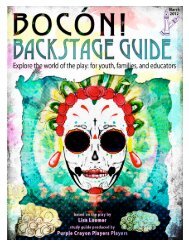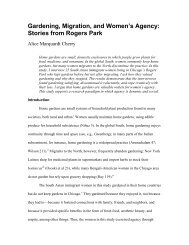research - Associated Student Government, Northwestern University
research - Associated Student Government, Northwestern University
research - Associated Student Government, Northwestern University
You also want an ePaper? Increase the reach of your titles
YUMPU automatically turns print PDFs into web optimized ePapers that Google loves.
RESEARCHgood end and the degree of good produced proportionallyoutweighs the evil of the side effect. 42 Therefore,the neutral act of using a condom within a marriage inwhich one or both partners have HIV/AIDS is used forthe purpose of a good end, the prevention disease transmission.Contraception is merely a side effect. Ethicistsreach this reevaluation – which states that an agent mayuse a condom to prevent disease transmission so longas the agent does not intend for its use to result in contraception–through a shift in focus (not abandonment)on Church traditions and scripture. Many principlesof contraceptives remain unchanged. For example, thisview would still condemn condoms for the purpose ofcontraception within or outside of a marriage.Pope Benedict XVI has not authorized the viewof condoms from this paradigm. However, progresswithin the Church follows a slow and arduous path. 43The increased support among Catholic ethicists andactions of Catholic missionaries suggest that the moralteachings of contraceptives have the potential for greatchange and that opposition to condoms may graduallydiminish. An eventual acceptance of condoms in thecontext of HIV/AIDS would help to unite “official” and“unofficial” policy and dispel confusion.ConclusionMy <strong>research</strong> has shown that Catholics can be an effectivegovernmental partner and in some cases have anadvantage in fighting HIV/AIDS. Global health studiesindicate that the disease has social, economic, andcultural components that are strongly influenced by thesurrounding environment and that these factors mustbe addressed for successful prevention and treatment.Catholics have established ties in African communitiesand a commitment to development giving them muchstrength in addressing all aspects of the disease. Personalaccounts of fieldwork in Africa indicate that practiceson the ground concentrate on issues other than sexuality,and an analysis of ethics show that historic viewson contraceptive may be waning and a new ethical approachalready exists. The Catholic Church has abilitiesand strengths that science cannot target alone. Therefore,the Catholic Church’s resources, knowledge, andpast experiences should be utilized when creating approachesfor addressing the HIV/AIDS epidemic.Endnotes1 The AIDS2031 Consortium, AIDS: Taking a Long-Term View (Saddle River, New Jersey:Financial Times Press Science, 2011), xi.2 “President’s Emergency Plan for AIDS Relief (PEPFAR),”AVERT(Averting HIV and AIDS),accessed March 5, 2011, http://www.avert.org/pepfar.htm.3 Scott H Evertz, the Council for Global Equality, “How Ideology Trumped Science,”(January 2010): 2, accessed March 13, 2011, http://www.americanprogress.org/issues/2010/01/pdf/pepfar.pdf.4 “President’s Emergency Plan for AIDS Relief (PEPFAR).”5 UNAIDS, “The Global HIV Challenge,” 886 Emmanuel Katongle, “AIDS, Africa, and the ‘Age of Miraculous Medicine’,” in AppliedEthics in a World Church: The Padua Conference, ed. Linda Hogan, 144 ((Maryknoll,New York: Orbis Books, 2008).VOLUME 7, 2011-20127 UNAIDS, “The Global HIV Challenge,” 888 “Women and HIV/AIDS,” The National Women’s Health Information Center, last modifiedMarch 4, 2009, accessed March 13, 2011, http://www.womenshealth.gov/hiv/gender/index.cfm#biological.9 The AIDS2031 Consortium, AIDS, 9.10 Maria Cimperman, When God’s People Have HIV/AIDS: An Approach to Ethics (Maryknoll,New York: Orbis Books, 2005), 13.11 Paul Farmer, “Condoms, Coups, Ideology of Prevention: Facing Failure in Rural Haiti inCatholic Ethicists on HIV/AIDS, eds. James F. Keenan et al., 188 (New York: Continuum,2000).12 Willem Saayman, “Aids, Healing and Culture in Africa: A Christian Mission Perspective,”Journal of Theology for Southern Africa, (March 1, 1992): 44, accessed March 9,2011,13 Saayman,”Aids, Healing and Culture in Africa,” 45.14 Steinberg, Sizwe’s Test, 25115 Saayman, “Aids, Healing and Culture in Africa,” 43.16 Steinberg, Sizwe’s Test, 139.17 Steinberg, Sizwe’s Test, 91.18 Saayman, “Aids, Healing and Culture in Africa,” 41.19 Katongle, “AIDS, Africa, and the ‘Age of Miraculous Medicine’,” 145.20 Bertrand Lebouche, Jean-Francois Malherbe, Christian Trepo, and Raymond Lemieux,“Religion in the AIDS Crisis: Irrelevance, Adversary, or Ally?,” in Applied Ethics in aWorld Church: The Padua Conference, ed. Linda Hogan, 174 (Maryknoll, New York:Orbis Books, 2008).21 Paul Chummar, “HIV/AIDS in Africa,” in Applied Ethics in a World Church: The PaduaConference, ed. Linda Hogan, 155 (Maryknoll, New York: Orbis Books, 2008).22 Andrew Natsios, interviewed by Luis Lugo, “Religion and International Development:A Conversation with Andrew Natsios,” The Pew Forum on Religion and Public Life,March 1, 2006.23 Stuart C. Bate, “Counseling: Differences in Confessional Advice in South Africa,” inCatholic Ethicists on HIV/AIDS, eds. James F. Keenan et al., 213 (New York: Continuum,2000).24 Farmer, “Condoms, Coups, Ideology,” 109.25 Chris Carroll (<strong>Northwestern</strong> sociology graduate student), in discussion with theauthor, November 201026 Nicholas D. Kristof, “A Church Mary Can Love,” New York Times, April 17, 2010, accessedFebruary 26, 2011, http://www.nytimes.com/2010/04/18/opinion/18kristof.html?scp=1&sq=catholic%20church%20mary&st=cse.27 The AIDS2031 Consortium, AIDS, 25.28 Bate, “Counseling,” 217.29 Pope Paul VI, Humanae Vitae, Encyclical letter on the regulation of birth (July 25,1968). Vatican Website, accessed November 23, 2010, http://www.vatican.va/holy_father/paul_vi/encyclicals/documents/hf_p-vi_enc_25071968_humanaevitae_en.html,para 5.30 Paul VI, Humanae Vitae, para 5.31 Paul VI, Humanae Vitae, para 5.32 Paul VI, Humanae Vitae, para 5.33 Paul VI, Humanae Vitae, para 14.34 Paul VI, Humanae Vitae, para 21.35 Marciano Vidal, “Progress in the Moral Tradition,” in Catholic Ethicists on HIV/AIDS,eds. James F. Keenan et al., 259 (New York: Continuum, 2000).36 Gallagher, “Catholic Medical Ethics,” 279.37 Gallagher, “Catholic Medical Ethics,” 273.38 Paul VI, Humanae Vitae, para 15.39 Gallagher, “Catholic Medical Ethics,” 281.40 Gallagher, “Catholic Medical Ethics,” 281.41 Gallagher, “Catholic Medical Ethics,” 281.42 James F. Keenan, “The Function of the Principle of Double Effect,” Theological Studies54, no.2 (1993), 300.43 Gallagher, “Catholic Medical Ethics,” 315.44 Gallagher, “Catholic Medical Ethics,” 315.NORTHWESTERN UNDERGRADUATE RESEARCH JOURNAL17


